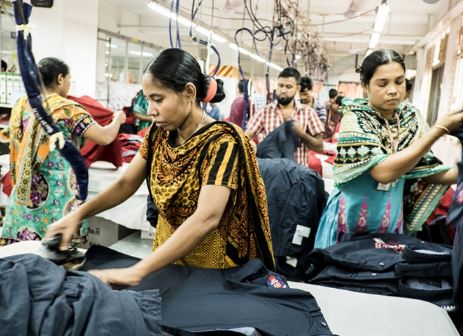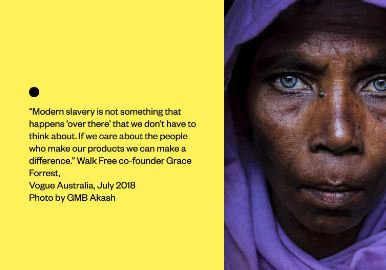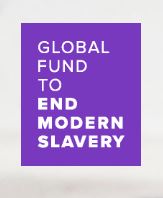The Truth Behind Modern Slavery
Moda Circolare – Guest Interview with Camila Gomez Wills
 Camila Gomez Wills
Camila Gomez Wills
If you are a regular person, that lives a regular normal life, and you do regular things (just like me), you may not realize that Modern Slavery is a real everyday occurrence that happens in so many countries. I had the privilege of interviewing an expert in the field of Modern Slavery, Camila Gomez Wills.
Camila is a Colombian attorney with experience in program management, stakeholder engagement, and international research. She recently finished a Master’s in Public Policy focused on best practices to address modern slavery in global supply chains at the University of California, San Diego.
Below I asked her 6 basic but highly pertinent questions. The questions and answers are below.
- What is modern slavery?
Modern Slavery is an umbrella term that covers different forms of labor exploitation and human rights violations including debt bondage, forced labor, labor trafficking, child labor, among others. Some people think that slavery is a part of our collective past. Sadly, that is not the case and it is a rapidly growing crime. The COVID-19 pandemic has worsened the problem as the economic crisis has pushed more people into dire financial conditions that make them more vulnerable to exploitation.

- Does modern slavery exist in the Fashion Industry?
Modern Slavery exists in almost all industries and fashion is not immune to the problem. If you think about it, there are many steps and people involved with getting the shirt you are wearing into your hands. Where did the raw materials come from? Who picked the cotton? Where? And from then, who spun it, wove it, dyed it, cut it, sewed it? If you complete the circular loop and include the end of life of the garment, the questions continue: who will sort the clothes, where will the sorting take place? Each of the steps in the apparel supply chain needs to be evaluated for its risks of human rights violations.

The recent scandal surrounding factories manufacturing for Boohoo in Leicester that were grossly underpaying their workers or the focus on cotton from Xinjiang and the working conditions of Uyghurs are just two examples of a far-reaching problem.
- What countries are impacted by modern slavery and specifically modern slavery as it pertains to the Fashion Industry?
Modern slavery is not an issue that only happens “far away” or in the Global South. All countries have vulnerabilities. The two examples I just mentioned include China and the UK. Other recent investigations have dove into working conditions of migrants in Italy’s high end fashion manufacturing, or the lack of safe working environments of the homeworkers that embellish our clothes.
- What can consumers do to make the right decisions when it comes to choosing brands to support?
Consumers need to pay more attention to the clothes they are purchasing and what the brand they are buying from stands for. Where are the clothes made? Does the brand have a human rights policy or Modern Slavery statement on the website? If not, consumers can use their voice to ask those questions to the brands they love.

- As a brand, what can they do to ensure there is no modern slavery utilized in their supply chains?
At a basic level, brands need to know who their suppliers are and have a full mapping of at least their first tier. This mapping will allow the brand to identify and prioritize risks. If a problem or non-compliance is found, brands must react with remediation as a first line. Terminating a contract with a supplier should be the last resort.
Another step in the right direction is to develop a high-level commitment approved by their board to incorporate human rights policies into their supplier contracts and vendor agreements. These policies need to be backed by robust due diligence, training, and a true cooperation with suppliers to ensure that the purchasing practices themselves are not contributing to the problem. In other words, if a brand changes their order or gives very short lead times, this could be driving excessive overtime at a factory level. It is important to note that these policies and statements are already a legal requirement in many countries and mandatory human rights due diligence is a growing field for regulation.
- What are the largest organizations and non-profits working in this area and making the largest impacts?
I admire the work the Global Fund to End Modern Slavery (GFEMS) is doing. They fund initiatives that address the root causes of Modern Slavery around the world and approach the issue from an economic/market angle. At the end of the day, the crime needs to be unprofitable.

If you want more information on Modern Slavery you can contact Camila Gomez Wills through the links below.
About the author:

Elizabeth Cross is the founder and CEO of Moda Circolare, a sustainable fashion consulting agency. Moda Circolare, helps fashion and apparel brands embed sustainability into their current business strategies. Moda Circolare’s mandate is to help the fashion industry live in harmony with nature and they do this by working with clients conducting sustainability assessments, completing eco-certifications and improving their sustainability commitments.
If you are looking to build a Sustainability Strategy or to create a Modern Slavery Policy, please contact us.
Error: Contact form not found.
